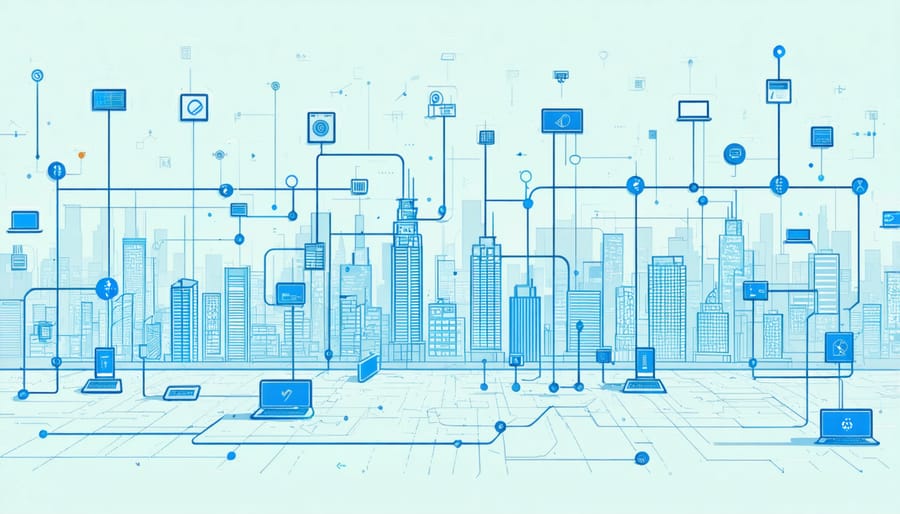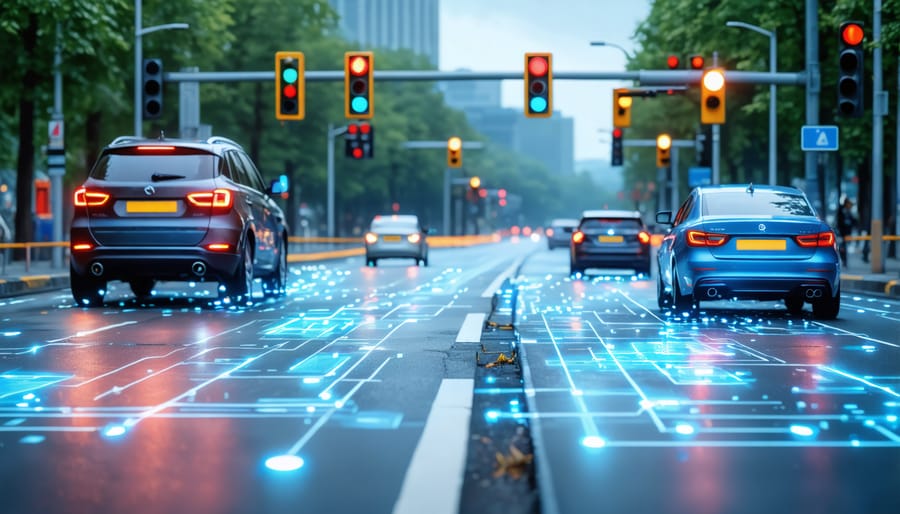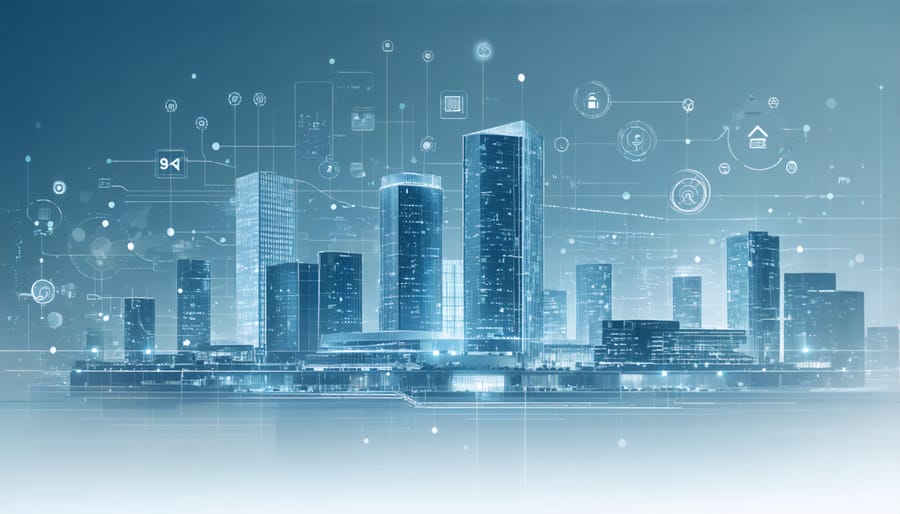Smart city development stands at the forefront of modern urban evolution, revolutionizing urban living through integrated digital infrastructure and data-driven solutions. As construction professionals navigate this transformative landscape, the convergence of Internet of Things (IoT) sensors, artificial intelligence, and advanced construction methodologies is reshaping how we conceptualize, build, and manage urban environments. The integration of smart technologies into traditional infrastructure development demands a fundamental shift in project planning, execution, and long-term maintenance strategies.
Recent analyses indicate that the global smart cities market is projected to exceed $2.5 trillion by 2026, driven by unprecedented urbanization rates and the pressing need for sustainable, resilient urban infrastructure. This rapid evolution presents both opportunities and challenges for construction professionals, requiring expertise in not only traditional building practices but also in implementing sophisticated sensor networks, automated systems, and intelligent infrastructure components.
For industry stakeholders, understanding the intricate relationship between physical infrastructure and digital technology has become crucial, as smart city development transforms from an aspirational concept into a practical necessity that demands immediate attention and expertise.
The Foundation of Smart Infrastructure

IoT Integration and Sensor Networks
IoT integration and sensor networks form the backbone of modern smart city infrastructure, enabling real-time monitoring and data-driven decision-making across urban environments. These systems typically comprise interconnected sensors strategically placed throughout the city’s infrastructure to collect crucial environmental, traffic, and utility data.
Key sensor implementations include environmental monitoring stations that track air quality, noise levels, and weather conditions; traffic management sensors that monitor vehicle flow and pedestrian movement; and utility sensors that measure water usage, power consumption, and waste management efficiency. These devices communicate through secure mesh networks, utilizing protocols such as LoRaWAN and NB-IoT, which are specifically designed for long-range, low-power urban applications.
Recent advancements in sensor technology have significantly reduced implementation costs while improving accuracy and reliability. For instance, smart lighting systems now incorporate multiple sensors within single units, monitoring both illumination needs and gathering environmental data, maximizing infrastructure efficiency.
The integration of these networks requires careful consideration of power requirements, data security, and maintenance accessibility. Successful implementations typically feature redundant communication paths, robust cybersecurity measures, and scalable data management systems. Cities like Barcelona and Singapore demonstrate how comprehensive sensor networks can reduce operational costs by up to 30% while improving service delivery and citizen satisfaction.
For optimal performance, sensor placement strategies must account for urban topology, electromagnetic interference, and future expansion capabilities, ensuring long-term sustainability and adaptability of the smart city infrastructure.
Data Analytics and AI Systems
Data analytics and artificial intelligence serve as the central nervous system of smart city infrastructure, enabling real-time monitoring, predictive maintenance, and optimized resource allocation. Advanced sensor networks deployed throughout urban environments collect vast amounts of data on traffic patterns, energy consumption, waste management, and public utility usage.
These systems utilize machine learning algorithms to process and analyze data streams, identifying patterns and anomalies that human operators might miss. For instance, AI-powered traffic management systems can automatically adjust signal timing based on current traffic conditions, reducing congestion by up to 25% in pilot cities.
Predictive maintenance applications leverage historical data and real-time monitoring to forecast potential infrastructure failures before they occur. This proactive approach has demonstrated cost savings of 15-30% in maintenance operations while significantly reducing system downtime.
Smart grid management systems employ AI to balance power distribution, integrate renewable energy sources, and respond to demand fluctuations in real-time. These systems can reduce energy waste by up to 20% through intelligent load balancing and demand response programs.
Cloud-based platforms integrate these various data streams into unified dashboard interfaces, allowing city managers to make informed decisions based on comprehensive analytics. Machine learning models continuously improve their accuracy through iterative learning, enhancing the precision of predictions and recommendations for infrastructure optimization.
The implementation of these technologies requires careful consideration of data security, privacy protocols, and system interoperability to ensure robust and reliable urban infrastructure management.
Smart Infrastructure Components
Intelligent Transportation Systems
Intelligent Transportation Systems (ITS) form a critical backbone of smart city infrastructure, integrating advanced technologies to optimize traffic flow and enhance urban mobility. These systems leverage real-time data analytics, artificial intelligence, and IoT sensors to create a seamless transportation network that responds dynamically to changing conditions.
At the core of ITS implementation are smart traffic management systems that utilize adaptive traffic signals, which adjust timing based on real-time traffic volumes and patterns. These systems can reduce congestion by up to 25% and decrease average travel times by 15-20% in urban corridors.
Connected vehicle infrastructure (V2I) technology enables communication between vehicles and roadside equipment, improving safety and efficiency. This includes smart parking systems, electronic toll collection, and emergency vehicle preemption systems. Cities like Singapore and Copenhagen have demonstrated how these technologies can reduce traffic-related incidents by up to 40%.
The integration of autonomous vehicles into urban transportation networks represents the next frontier in ITS development. Smart cities are incorporating dedicated lanes, specialized signaling systems, and charging infrastructure to support autonomous vehicle operations. This requires careful consideration of infrastructure modifications, including enhanced road markings, sensor networks, and high-precision GPS systems.
Real-world implementations have shown that successful ITS deployment depends on robust communication networks, standardized protocols, and comprehensive cybersecurity measures. Cities must develop flexible infrastructure that can adapt to emerging transportation technologies while ensuring system reliability and data protection.

Smart Energy Grids
Modern cities are increasingly adopting smart energy grid systems to revolutionize power distribution and management. These advanced systems integrate renewable energy sources, storage solutions, and intelligent monitoring capabilities to create a more resilient and efficient urban power infrastructure.
The implementation of smart grids enables real-time load balancing and demand response mechanisms, significantly reducing energy waste and operational costs. Advanced metering infrastructure (AMI) provides granular consumption data, allowing utilities to optimize distribution patterns and quickly respond to fluctuations in demand. This technology has demonstrated up to 30% improvement in grid efficiency in pilot projects across major metropolitan areas.
Renewable energy integration plays a crucial role in these systems, with solar and wind power installations being seamlessly incorporated into the existing grid infrastructure. Energy storage solutions, including grid-scale batteries and distributed storage systems, help manage intermittency issues and ensure consistent power supply during peak demand periods.
Recent innovations in grid automation and self-healing capabilities have enhanced system reliability, with some cities reporting a 45% reduction in power outages. Machine learning algorithms continuously analyze grid performance data, predicting potential failures and automatically rerouting power to prevent service interruptions. This predictive maintenance approach has proven particularly valuable in reducing infrastructure maintenance costs while improving service reliability.
Smart Buildings and Facilities
Smart buildings represent the cornerstone of modern urban development, integrating sophisticated automation systems with energy-efficient technologies to create responsive, sustainable environments. These intelligent structures leverage Internet of Things (IoT) sensors and advanced Building Management Systems (BMS) to optimize operations across multiple functions, from HVAC and lighting to security and occupancy management.
Recent implementations demonstrate that buildings equipped with smart systems achieve 25-35% greater energy efficiency compared to conventional structures. This improvement is largely attributed to AI-driven controls that automatically adjust building operations based on real-time usage patterns and environmental conditions. The integration of smart building sustainability metrics has become essential for measuring and optimizing facility performance.
Advanced utility management systems play a crucial role, incorporating smart meters and predictive maintenance protocols that significantly reduce operational costs. These systems monitor water consumption, power usage, and waste management in real-time, enabling facility managers to identify inefficiencies and implement immediate corrections.
Building automation extends to access control, elevator systems, and parking management, creating seamless experiences for occupants while maintaining robust security protocols. The integration of digital twins further enhances facility management by providing virtual models for testing operational scenarios and optimizing building performance before implementing changes in the physical environment.

Implementation Challenges and Solutions
Technical Integration Hurdles
The integration of diverse technological systems within smart cities presents several significant technical hurdles that demand careful consideration and strategic solutions. Legacy infrastructure compatibility remains a primary challenge, as existing urban systems must seamlessly interface with new smart technologies. This often requires the development of custom middleware solutions and API frameworks to bridge the technological gap.
Data standardization and interoperability pose another crucial challenge. Different vendors and systems often utilize proprietary protocols and data formats, making system-wide integration complex. Construction professionals must implement standardized communication protocols and data exchange formats to ensure smooth information flow across various urban subsystems.
Cybersecurity concerns become increasingly critical as cities expand their digital infrastructure. The interconnected nature of smart city systems creates multiple potential vulnerabilities that require robust security measures. Implementation of end-to-end encryption, secure authentication protocols, and regular security audits has become essential for protecting critical infrastructure.
Network capacity and reliability present ongoing challenges, particularly in dense urban environments. The massive volume of data generated by IoT sensors and smart devices requires robust network infrastructure with sufficient bandwidth and minimal latency. Construction teams must carefully plan network architecture, incorporating redundancy and failover systems to ensure continuous operation.
Power management and energy efficiency pose significant technical hurdles. Smart city systems require consistent power supply and efficient energy distribution networks. Solutions include implementing smart grid technologies, distributed energy resources, and advanced power management systems to ensure reliable operation while minimizing energy consumption.
These challenges necessitate a comprehensive approach to system integration, with careful attention to scalability, maintainability, and future expansion capabilities. Successful implementation requires close collaboration between construction professionals, technology vendors, and urban planners to develop integrated solutions that address these technical hurdles effectively.
Security and Privacy Considerations
As smart cities become increasingly interconnected, robust infrastructure security measures are paramount to protect against cyber threats and ensure data privacy. Construction professionals must integrate multi-layered security protocols during the development phase, implementing end-to-end encryption for all IoT devices and sensors deployed across the urban landscape.
Data protection strategies should include secure authentication mechanisms, regular security audits, and real-time monitoring systems. Smart city infrastructure requires dedicated security operations centers (SOCs) to oversee network security and respond to potential breaches. These centers must be incorporated into the architectural planning phase to ensure proper integration with existing systems.
Privacy considerations extend beyond cybersecurity to include citizen data protection. Smart city developers must implement privacy-by-design principles, ensuring that data collection is transparent, purposeful, and compliant with regulations such as GDPR and local privacy laws. This includes implementing data minimization practices, secure storage protocols, and clear data retention policies.
Physical security measures are equally crucial, requiring secure access controls for critical infrastructure components and edge computing facilities. Construction teams must integrate these security elements seamlessly into the urban fabric while maintaining accessibility for maintenance and emergency responses.
Regular security assessments and updates must be factored into the long-term maintenance plans, with systems designed to accommodate future security enhancements. This forward-thinking approach ensures that smart city infrastructure remains resilient against evolving cyber threats while protecting citizen privacy.
As we look toward the future of urban development, smart infrastructure stands as the cornerstone of sustainable, efficient, and livable cities. The integration of IoT sensors, artificial intelligence, and data analytics is reshaping how we plan, build, and manage urban environments. Industry experts project that by 2030, over 60% of the world’s infrastructure projects will incorporate smart technologies, fundamentally transforming the construction landscape.
The convergence of digital innovation and traditional infrastructure creates unprecedented opportunities for construction professionals. Real-time monitoring systems, predictive maintenance protocols, and automated building management solutions are becoming standard features rather than luxury additions. This evolution demands a shift in approach from conventional construction methodologies to technology-driven project execution.
The impact of smart infrastructure extends beyond operational efficiency. Cities implementing comprehensive smart solutions report average cost savings of 25-30% in utility management and maintenance operations. Furthermore, these systems contribute significantly to sustainability goals, with smart buildings reducing energy consumption by up to 35% compared to traditional structures.
Looking ahead, the success of smart city initiatives will depend heavily on the construction industry’s ability to adapt and innovate. The integration of 5G networks, edge computing, and advanced materials science will create new possibilities for infrastructure development. Construction professionals must stay ahead of these technological advancements while maintaining focus on practical implementation and return on investment.
The future also brings challenges that require careful consideration. Cybersecurity, data privacy, and system interoperability remain critical concerns that must be addressed through robust planning and implementation strategies. Success in smart city development will require closer collaboration between construction professionals, technology providers, and urban planners.
As we move forward, the construction industry’s role in shaping smart cities becomes increasingly vital. The future of urban development lies not just in building structures, but in creating intelligent, responsive environments that enhance quality of life while optimizing resource utilization. This transformation represents both a challenge and an opportunity for construction professionals to lead the way in building the cities of tomorrow.

